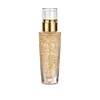What's inside
What's inside
 Key Ingredients
Key Ingredients

 Benefits
Benefits

 Concerns
Concerns

 Ingredients Side-by-side
Ingredients Side-by-side

Water
Skin ConditioningPropanediol
SolventGlycerin
HumectantPhenoxyethanol
PreservativeCarbomer
Emulsion StabilisingImidazolidinyl Urea
PreservativeEthylhexylglycerin
Skin ConditioningParfum
MaskingDisodium EDTA
Sodium Hydroxide
BufferingPisum Sativum Extract
Skin ConditioningSodium Citrate
BufferingBiosaccharide Gum-1
HumectantAlcohol
AntimicrobialSodium Hyaluronate
HumectantPolysorbate 80
EmulsifyingGlycyrrhiza Glabra Root Extract
BleachingLecithin
EmollientSodium Benzoate
MaskingSoy Isoflavones
Skin ConditioningPotassium Sorbate
PreservativeWater, Propanediol, Glycerin, Phenoxyethanol, Carbomer, Imidazolidinyl Urea, Ethylhexylglycerin, Parfum, Disodium EDTA, Sodium Hydroxide, Pisum Sativum Extract, Sodium Citrate, Biosaccharide Gum-1, Alcohol, Sodium Hyaluronate, Polysorbate 80, Glycyrrhiza Glabra Root Extract, Lecithin, Sodium Benzoate, Soy Isoflavones, Potassium Sorbate
Water
Skin ConditioningButylene Glycol
HumectantGlycerin
HumectantPropanediol
SolventAlcohol
AntimicrobialPhenoxyethanol
PreservativeGlyceryl Tetrahydrofarnesylacetate
EmulsifyingSodium Citrate
BufferingPEG/PPG-200/70 Copolymer
SolventEthylhexylglycerin
Skin ConditioningAlcaligenes Polysaccharides
EmollientAlbatrellus Ovinus Extract
Skin ConditioningHydrangea Paniculata Flower/Fruit Extract
EmollientCitric Acid
BufferingOrobanche Rapum Extract
Skin ProtectingPotentilla Miyabei Callus Extract
Skin ConditioningCeramide Ng
Skin ConditioningWater, Butylene Glycol, Glycerin, Propanediol, Alcohol, Phenoxyethanol, Glyceryl Tetrahydrofarnesylacetate, Sodium Citrate, PEG/PPG-200/70 Copolymer, Ethylhexylglycerin, Alcaligenes Polysaccharides, Albatrellus Ovinus Extract, Hydrangea Paniculata Flower/Fruit Extract, Citric Acid, Orobanche Rapum Extract, Potentilla Miyabei Callus Extract, Ceramide Ng
Ingredients Explained
These ingredients are found in both products.
Ingredients higher up in an ingredient list are typically present in a larger amount.
Alcohol comes in many different forms. Different types of alcohol will have different effects on skin. This ingredient is usually an astringent alcohol.
These alcohols are drying on the skin. They may strip away your skin's natural oils and even damage your skin barrier. Astringent alcohols may also irritate skin.
Other types of astringent alcohols include:
According to the National Rosacea Society based in the US, you should be mindful of products with these alcohols in the top half of ingredients.
Any type of sanitizing product will have high amounts of alcohol to help kill bacteria and viruses.
Fatty alcohols come from plant oils such as coconut oil. These can help hydrate the skin and are non-irritating. Some fatty alcohols include cetyl and stearyl alcohol.
Learn more about AlcoholEthylhexylglycerin (we can't pronounce this either) is commonly used as a preservative and skin softener. It is derived from glyceryl.
You might see Ethylhexylglycerin often paired with other preservatives such as phenoxyethanol. Ethylhexylglycerin has been found to increase the effectiveness of these other preservatives.
Glycerin is already naturally found in your skin. It helps moisturize and protect your skin.
A study from 2016 found glycerin to be more effective as a humectant than AHAs and hyaluronic acid.
As a humectant, it helps the skin stay hydrated by pulling moisture to your skin. The low molecular weight of glycerin allows it to pull moisture into the deeper layers of your skin.
Hydrated skin improves your skin barrier; Your skin barrier helps protect against irritants and bacteria.
Glycerin has also been found to have antimicrobial and antiviral properties. Due to these properties, glycerin is often used in wound and burn treatments.
In cosmetics, glycerin is usually derived from plants such as soybean or palm. However, it can also be sourced from animals, such as tallow or animal fat.
This ingredient is organic, colorless, odorless, and non-toxic.
Glycerin is the name for this ingredient in American English. British English uses Glycerol/Glycerine.
Learn more about GlycerinPhenoxyethanol is a preservative that has germicide, antimicrobial, and aromatic properties. Studies show that phenoxyethanol can prevent microbial growth. By itself, it has a scent that is similar to that of a rose.
It's often used in formulations along with Caprylyl Glycol to preserve the shelf life of products.
Propanediol is an all-star ingredient. It softens, hydrates, and smooths the skin.
It’s often used to:
Propanediol is not likely to cause sensitivity and considered safe to use. It is derived from corn or petroleum with a clear color and no scent.
Learn more about PropanediolSodium Citrate is the sodium salts of citric acid. In skincare, it is used to alter pH levels and acts as a preservative.
Its main functions are to maintain the pH of a product and neutralize metal ions.
The acidity of our skin is maintained by our glands and skin biome; normal pH level of skin is slightly acidic (~4.75-5.5).
Being slightly acidic allows our skin to create an "acid mantle". This acid mantle is a thin barrier that protects our skin from bacteria and contaminants.
Learn more about Sodium CitrateWater. It's the most common cosmetic ingredient of all. You'll usually see it at the top of ingredient lists, meaning that it makes up the largest part of the product.
So why is it so popular? Water most often acts as a solvent - this means that it helps dissolve other ingredients into the formulation.
You'll also recognize water as that liquid we all need to stay alive. If you see this, drink a glass of water. Stay hydrated!
Learn more about Water